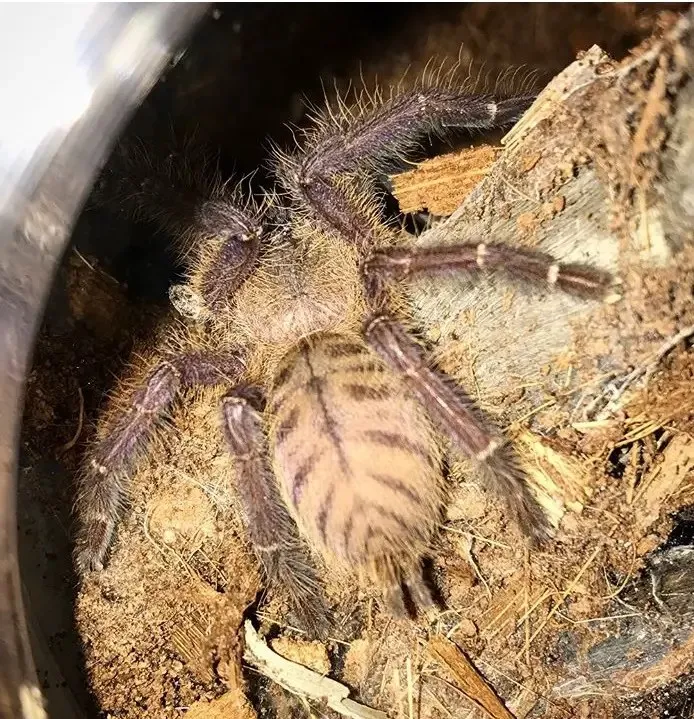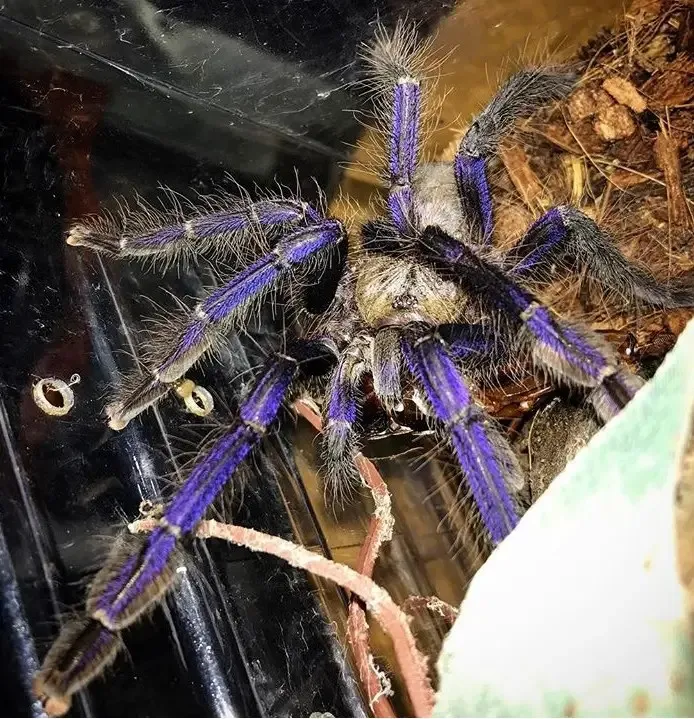What Makes the Singapore Blue Tarantula Poisonous
The Singapore Blue Tarantula, with its striking iridescent blue coloration, is a fascinating creature that often sparks curiosity about its venom. While the term “poisonous” is often used, it’s important to clarify that this species is, more accurately, venomous. Poisonous animals are harmful when touched or ingested, while venomous animals inject toxins through bites or stings. The Singapore Blue Tarantula, like all tarantulas, possesses venom that it uses to subdue its prey and defend itself. Understanding the composition and effects of this venom is crucial for anyone who may encounter this spider.
The Venom Composition of the Singapore Blue Tarantula
The venom of the Singapore Blue Tarantula is a complex mixture of various components, primarily proteins, peptides, and enzymes. These substances work synergistically to affect the nervous system and other physiological processes of its prey. The specific composition can vary slightly depending on factors like the tarantula’s age, diet, and overall health. The study of tarantula venom is an ongoing area of research, with scientists constantly uncovering new details about the specific compounds and their effects.
Neurotoxins and Enzymes

A significant portion of the Singapore Blue Tarantula’s venom consists of neurotoxins, which primarily target the nervous system. These neurotoxins disrupt the normal function of nerve cells, leading to paralysis or other neurological symptoms in the prey. Additionally, enzymes are present in the venom, which aid in breaking down tissues and facilitating the absorption of the venom’s components. Some enzymes can also contribute to the inflammatory response, further amplifying the effects of the venom.
How the Venom Affects Humans
While the Singapore Blue Tarantula’s venom is primarily designed to affect insects and small animals, it can also impact humans. The severity of the reaction varies greatly depending on individual sensitivity, the amount of venom injected, and the location of the bite. Most bites from this species are not life-threatening, but they can cause a range of unpleasant symptoms. It is important to be informed of the possible effects to be able to react promptly and correctly to any accident.
Local Reaction and Systemic Symptoms
The most common effects of a Singapore Blue Tarantula bite are localized to the bite site. These may include immediate pain, redness, swelling, and itching. In some cases, the area around the bite may become warm to the touch. Systemic symptoms, which affect the entire body, are less common but can occur. These can include muscle cramps, nausea, headache, and, in rare instances, more severe reactions. If systemic symptoms develop, it is crucial to seek medical attention as soon as possible.
Severity of a Bite

The severity of a Singapore Blue Tarantula bite can vary based on several factors. Generally, the bites are considered mild to moderate in severity. However, individual reactions can vary significantly. Some people may experience minimal symptoms, while others may have a more pronounced response. While fatalities from tarantula bites are extremely rare, it is still important to treat every bite with respect and seek medical advice if concerning symptoms develop. Proper first aid and medical assessment are essential for ensuring a safe recovery.
Factors Influencing Venom Potency
The potency of a Singapore Blue Tarantula’s venom is not a constant. Several factors can influence how potent the venom is at any given time. Understanding these factors can help in assessing the potential risks and knowing how to react in the event of a bite. These factors are connected to the tarantula itself and its environment. Considering these factors is essential to evaluate the possible severity of a bite from this spider.
Size and Age of the Tarantula
Larger, older tarantulas typically possess more potent venom than younger, smaller individuals. This is because they have had more time to develop and store venom. The amount of venom injected during a bite can also vary depending on the tarantula’s size. A larger tarantula is generally capable of delivering a greater quantity of venom than a smaller one. This means the potential impact of the bite is frequently related to the spider’s age and size.
Health of the Tarantula

A tarantula’s overall health can also affect its venom potency. A healthy tarantula, one that is well-fed and free from disease, is more likely to have potent venom. Conversely, a tarantula that is stressed, malnourished, or sick may produce less potent venom. Therefore, the condition of the tarantula is another aspect to consider when assessing the possible outcomes of a bite.
The Tarantula’s Last Meal
The timing of the tarantula’s last meal can also have a subtle influence on its venom. A well-fed tarantula might have slightly less potent venom, as its reserves are not depleted. The exact influence of diet is a complex area of research. Generally, it is unlikely to be a major factor in the bite’s overall impact compared to the spider’s health and size.
First Aid for a Singapore Blue Tarantula Bite
Knowing how to respond to a tarantula bite is crucial for minimizing harm and ensuring the best possible outcome. Immediate and appropriate first aid can reduce discomfort and prevent complications. Prompt action can significantly reduce the impact of the venom and improve the recovery process. These steps should be taken immediately after a bite, before seeking medical attention.
Immediate Steps to Take

If bitten by a Singapore Blue Tarantula, the first step is to remain calm. Gently clean the bite area with mild soap and water to prevent infection. Apply a cold compress or ice pack to the bite site to reduce pain and swelling. Elevate the affected limb, if possible, to minimize swelling. Monitor the person for any signs of allergic reaction or systemic symptoms, such as difficulty breathing, dizziness, or nausea. Document the time of the bite and any initial symptoms.
When to Seek Medical Attention
It is always a good idea to seek medical advice after a tarantula bite, even if the initial symptoms seem mild. Watch for any symptoms of an allergic reaction. If you experience systemic symptoms like muscle cramps, nausea, dizziness, or difficulty breathing, seek immediate medical help. A doctor can assess the situation, provide appropriate treatment, and rule out any serious complications. It’s important to describe the bite and any symptoms to the medical personnel accurately.
Long-Term Effects and Treatment
Most bites from the Singapore Blue Tarantula do not result in long-term health problems. The local symptoms usually resolve within a few days to a week. In rare cases, there may be some lingering sensitivity or discomfort at the bite site. The treatment is mainly focused on relieving symptoms and preventing complications. Understanding the typical course of recovery and the available treatments is key.
Antivenom Availability and Use

Currently, there is no specific antivenom available for Singapore Blue Tarantula venom. Medical treatment typically focuses on supportive care, such as pain relief medication, antihistamines to reduce itching, and anti-inflammatory drugs to manage swelling. In severe cases, hospitalization may be necessary to monitor the patient and provide additional support. The focus is on managing symptoms and allowing the body to recover. It is important to consult with medical professionals for appropriate treatment.
Preventing Bites from Singapore Blue Tarantulas
The best way to avoid the effects of the Singapore Blue Tarantula’s venom is to prevent bites in the first place. This involves understanding the spider’s behavior, handling practices, and its preferred environment. Adopting preventative measures is the safest way to interact with this fascinating creature. This can substantially lower the risk of a bite and the need for medical attention. The precautions outlined here are essential for safety.
Safe Handling Practices
If you are keeping a Singapore Blue Tarantula as a pet, it is vital to handle it safely and avoid unnecessary contact. Always handle the spider over a soft surface, such as a bed or a low table, to minimize the risk of injury if it falls. Avoid sudden movements, which can startle the spider. Use tools, such as long tongs, to move the tarantula if necessary. Educate yourself about tarantula behavior and learn to recognize signs of stress or aggression. When in doubt, it’s better to observe from a distance and avoid direct handling.
Environment Considerations

When keeping a Singapore Blue Tarantula, ensure that its enclosure is secure and escape-proof. Provide an appropriate habitat that mimics its natural environment. This includes a suitable substrate, hiding places, and proper temperature and humidity levels. Avoid placing the enclosure in a location where it can be easily disturbed or where children or pets can access it. Regular maintenance of the enclosure helps to prevent the spider from feeling stressed, reducing the likelihood of defensive behavior. Ensure a safe and stable environment contributes to a safe relationship with the tarantula.
